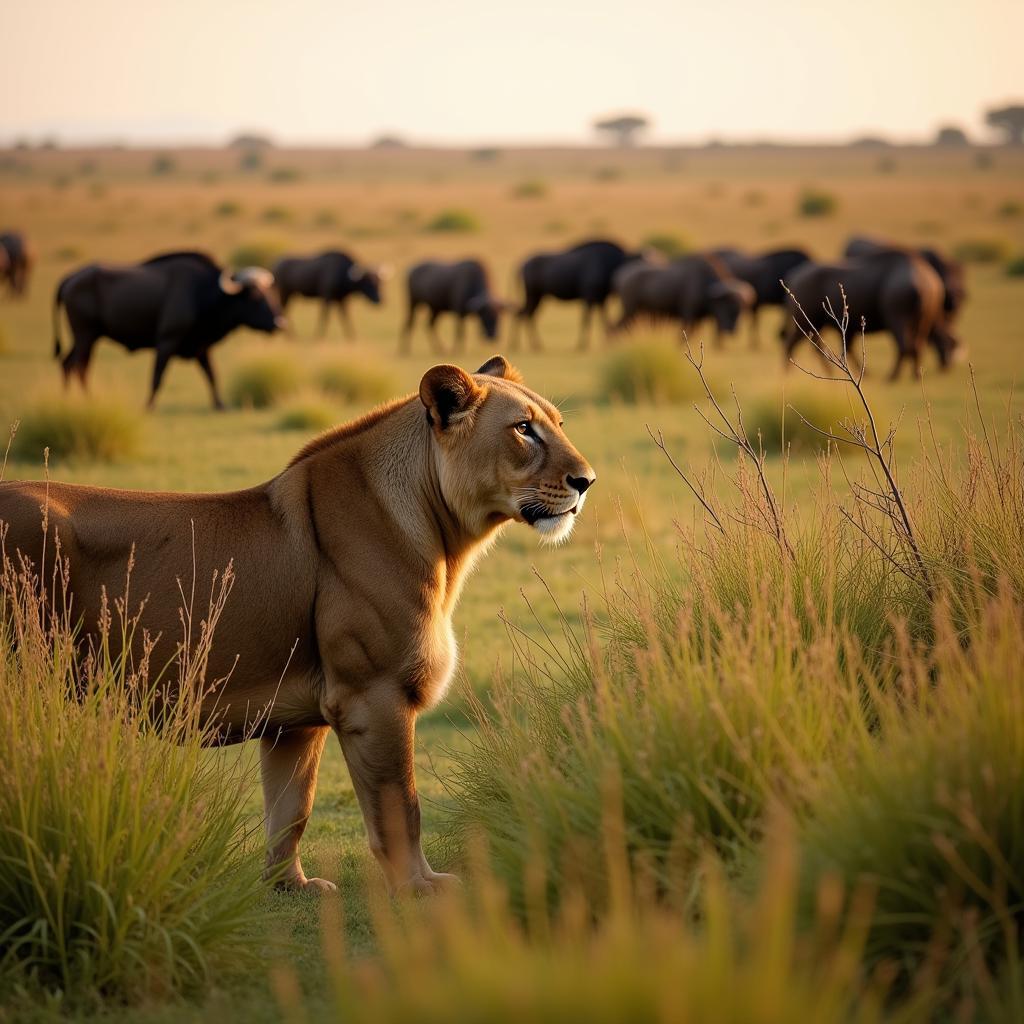The African Buffalo: A Powerful Icon of the Big 5 Animals
The African buffalo, a formidable member of the “African Buffalo Big 5 Animals” group, captivates wildlife enthusiasts with its imposing presence and unpredictable nature. Found roaming the savannas and woodlands of sub-Saharan Africa, these majestic creatures are a sight to behold, embodying the raw power and untamed spirit of the African wilderness.
Unveiling the African Buffalo: More Than Meets the Eye
Often described as a “black death” due to its notoriously unpredictable temperament, the African buffalo is much more than its fearsome reputation. They are highly social animals, living in herds that can number in the hundreds, and sometimes even thousands, strong. This strong social structure is key to their survival, providing protection from predators and enhancing their foraging efficiency.
Physical Characteristics: A Symphony of Strength
African buffalos are instantly recognizable by their massive size and distinctive horns. Their robust bodies can weigh up to a tonne, with males typically larger than females. Their most striking feature, however, is their horns. Fused at the base to form a formidable “boss” that covers their skull, the horns curve outwards and upwards, creating a formidable weapon against predators and rivals.
The Power of the Collective: Social Structure and Behavior
Within a herd, there is a complex social hierarchy, with older, more experienced females often leading the group. This social structure ensures the safety and well-being of the herd, with members looking out for each other and cooperating to raise young calves.
You can witness the incredible social dynamics of the African buffalo on an African buffalo safari. Witnessing a herd on the move, or observing their interactions, is an awe-inspiring experience that showcases the true spirit of these magnificent creatures.
The African Buffalo’s Place in the Ecosystem
As large herbivores, African buffalos play a crucial role in maintaining the delicate balance of the African ecosystem. Their grazing habits influence vegetation patterns, and their dung provides nutrients to the soil, supporting a diverse range of plant and animal life.
A Vital Link in the Food Chain: Predators and Prey
While the African buffalo is a formidable force in its own right, it does have natural predators. Lions, particularly, pose a threat, often targeting vulnerable individuals such as calves or sick animals. However, the buffalo’s strength in numbers and their fierce defensive instincts make them a challenging prey, even for the apex predator.
 Lion Stalking a Herd of African Buffalo
Lion Stalking a Herd of African Buffalo
“The African buffalo’s resilience and adaptability are a testament to their evolutionary success. They are not just survivors; they are thrivers, shaping the landscapes they inhabit and influencing the lives of countless other species.” – Dr. Amani Jabari, Wildlife Biologist
Threats and Conservation Efforts
Despite their vital role in the ecosystem, African buffalo populations face various threats. Habitat loss due to human encroachment, competition for resources with livestock, and diseases are all contributing factors to their decline in certain regions.
Ensuring a Future for the African Buffalo
Fortunately, conservation efforts are underway to protect this iconic species. Establishing protected areas, promoting sustainable land management practices, and controlling poaching are crucial steps in ensuring the long-term survival of the African buffalo.
The African Buffalo: An Enduring Symbol of Africa
The African buffalo, with its raw power, unpredictable nature, and vital role in the ecosystem, is an integral part of the African landscape. As a member of the “African buffalo big 5 animals”, it holds a special place in the hearts of wildlife enthusiasts and serves as a reminder of the importance of conservation efforts in protecting Africa’s natural heritage for generations to come.
FAQs about the African Buffalo
Q: Are African buffalos dangerous to humans?
A: Yes, African buffalos are considered one of the most dangerous animals in Africa. They are unpredictable and can charge with surprising speed and power.
Q: What is the lifespan of an African buffalo?
A: In the wild, African buffalos typically live for 15-20 years.
Q: What is the difference between an African buffalo and a water buffalo?
A: African buffalos are native to Africa, while water buffalos are native to Asia. They have distinct physical characteristics, including horn shape and body size.
Q: What do African buffalos eat?
A: African buffalos are herbivores, primarily feeding on grasses.
Q: Where can I see African buffalos in the wild?
A: You can find African buffalos in various national parks and reserves across sub-Saharan Africa. Some popular destinations include the Serengeti National Park, Kruger National Park, and Chobe National Park.
Interested in exploring the African wilderness? Discover incredible 7 day African safari tours that will immerse you in the beauty of these majestic creatures and their natural habitat. Capture stunning visuals of the wild with high-quality African cam equipment. Explore our collection of captivating 5k African wildlife photography and immerse yourself in the beauty of the African wilderness. Browse through vibrant images showcasing the lush landscapes and incredible biodiversity of the African jungle 1500 pixels.
For further information about the African buffalo and other fascinating wildlife, explore our website “African Life” or reach out to us. Contact us at +255768904061, email us at kaka.mag@gmail.com, or visit our office located in Mbarali DC Mawindi, Kangaga, Tanzania. Our dedicated customer service team is available 24/7 to assist you.